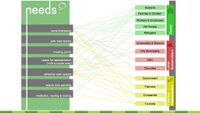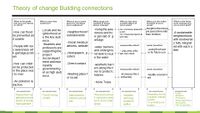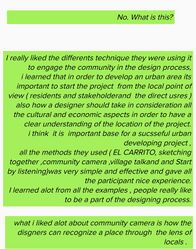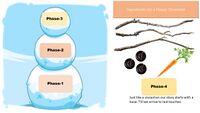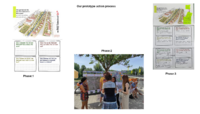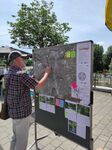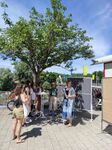LED2LEAP 2021 - Nürtingen Team 3: Difference between revisions
| Line 218: | Line 218: | ||
== The Realization of Your Prototyping Action == | == The Realization of Your Prototyping Action == | ||
It was exciting to see the public participate in the prototype action. We were also unsure whether they would participate or not, and how we would manage to guide them given the small number of people present. However, our advisors assist us greatly throughout the entire process, and together we make it possible to collect feedback from the community. | It was exciting to see the public participate in the prototype action. We were also unsure whether they would participate or not, and how we would manage to guide them given the small number of people present. However, our advisors assist us greatly throughout the entire process, and together we make it possible to collect feedback from the community. We can tell from community participation that people are concerned about the Steinach. They are bitterly disappointed and unhappy with the river's surrounding arrangement. They perceive it as a canal rather than a river. Furthermore, they want to see the Steinach as it once was. | ||
<gallery caption=" " widths="200px" heights="150px" perrow="5"> | <gallery caption=" " widths="200px" heights="150px" perrow="5"> | ||
Revision as of 11:04, 5 July 2021
>>>back to working groups overview
For help with editing this Wiki page use this link.
For assignments and key readings use this link.
Landscape Democracy Rationale
- Nürtingen is a town in the district of Esslingen in the German state of Baden-Württemberg.
- The area we sought as an important project site is the central part of the city of Nürtingen. The main reason is because this part is where many families assemble to have fun. Also the area is characterised by the existance of urban settlements, a small forest, urban garden, some commercial areas, historical artefacts and a beer garden on the north side of the river.
Location and Scope
- The area we worked on is:
Phase A: Mapping Your Community
Welcome to Your Community and Their Landscape
- The community in discussion offers lots of green artefacts like the forest and small recreational landscapes in addition to the Neckar and Steinach rivers. In addition to that, we noticed some irregularities like: No direct connection to the bridge, less seating place in the park Near the riverbank, there is an unutilized landscape, the river embankment is not well developed.
Groups of Actors and Stakeholders in Your Community
- As for actors and stakeholders, we have: CITY PLANNERS; City Municipality; NGO; Students; Neighborhood People; Corona Virus; People from other Neighborhoods.
Relationships Between Your Actors and Groups
- As for relationship between the actors we have represented that in a map. in which we have simplified the interaction between these actors from the most important interactive actors to the less ones. So from the center to the outer layer.
Theory Reflection
- The reading part of "Council of Europe Landscape Convention Contribution to human rights, democracy and sustainable development": Participatory process needs funding due to the continuity of its process. It also includes a wide public in the process.
- The reading part of "Landscape culture, culturing landscape" is well explained in the second map 2.
- The reading part of "The European Landscape Convention (Florence, 2000)" is well explained in the second map 3.
References
- European Landscape Convention (Florence, 2000).
- Landscape Culture - Culturing Landscapes (Kühne, Bruns et al, 2015).
- Landscape Convention Contribution to human rights, democracy and sustainable development(Council of Europe, 2018).
Phase B: Democratic Landscape Analysis and Assessment
Ahmed Essounni and Abhishek Vekariya and Tiffany Liu Correspondence
Shabnaz Tabassum and Mai Laila Correspondence
Your Name and Partner's Name Correspondence
- ''insert text here''
Arbil Al-Kubati and Ali Elbanna Correspondence
- ''insert text here''
Your Name and Partner's Name Correspondence
- ''insert text here''
Phase C: Collaborative Visioning and Goal Setting
The Scene in Your Story of Visioning
We chose the central part of Nürtingen, which is the city's historical site. It is close to the Neckar River. Residential settlements are the ones that are more visible on this site. There are also schools, an urban garden, sports facilities, and a few retail stores, and the community is linked to the main road. The main issue with this community is that it is not well connected to the Neckar River. The challenges depicted in the figure below describe the problems of this selected.
The Actors in Your Story of Visioning
- The actors of this community are elder people, young people, kids, municipality, local authorities, and the migrant's people, who are the user of this selected landscape.
The Story of Visioning
Our goal will be to "save the snowman." We all know that snow makes us happy, and people get together to build a snowman. In this case, we use the metaphor of a snowman to connect with the community. Building snowmen bring people around each other. And, as a result of climate change, this snowman is no longer visible. Because of the less accessibility, the community is separated from the landscape facilities at the site we have chosen. Our plan is to improve landscape connectivity and connect it to the community. For this, we considered increasing green space and establishing pocket parks. Seating areas near the river, as well as bike path connectivity throughout the Neckar. We would like to connect with the community and involve them throughout this process to save the snowman.
Reflect on Your Story of Visioning
- insert text here
Phase D: Collaborative Design, Transformation and Planning
Your Prototyping Action
Postcard for the community to have feedback from them and include it in our plan, Quiz to the community to draw the rivers in Nürtingen, Map to mark with green and orange flag that the green for the place they prefer to stay and the orange for the place they want to change in Nürtingen, with some pictures to write feedback on, Historical map to show how the river has changed, Facebook page to have more feedbacks.
The Evolution of Your Prototyping Action
During the COVID-19 Pandemic, it was impossible for all IMLA students to participate in this prototype action. For this, the students in Nürtingen work together with our university advisors to carry out this prototype action.
As a Nürtingen team 3, we divided our prototype method into three phases.
Phase 1: We created a postcard and distributed it to the prototype action participants (Nürtingen residents).
Phase 2: We describe the process of this action to them and ask them to try it.
Phase 3: We collect their feedback from the postcards and incorporate it into our final design.
The Plan Behind Your Prototyping Action
Prototyping is an essential component in design to collect the user experience of a plan. It allows us to test our ideas and improve on them quickly. For our project, our plan is to involve the community throughout the process. Our plan was to guide them to identify their current problems, describe them about our design plan and asked their ideas for example what types of changes they want from us and then implement them through our action.
The Realization of Your Prototyping Action
It was exciting to see the public participate in the prototype action. We were also unsure whether they would participate or not, and how we would manage to guide them given the small number of people present. However, our advisors assist us greatly throughout the entire process, and together we make it possible to collect feedback from the community. We can tell from community participation that people are concerned about the Steinach. They are bitterly disappointed and unhappy with the river's surrounding arrangement. They perceive it as a canal rather than a river. Furthermore, they want to see the Steinach as it once was.
Reflect on Your Prototyping Action
- prototyping action has allow us to reach community needs and concerning in the area that will be easer for us to do the planning process accordingly. community were exiting to help and give their suggestion in the places they prefer to stay in, and the places need to be fixed and how do they want to fix it, group has a bigger image in how to make the area fixed according to community needs.
Phase E: Collaborative Evaluation and Future Agendas
Collaborative Evaluation and Landscape Democracy Reflection
- insert text here
The Actors in your Collaborative Evaluation
- insert text here
Reflection on the Online Seminar
- insert text here
Reflection on the Living Lab Process
- insert text here
Your Living Lab Code of Conduct
- insert text here
Process Reflection
- insert text here





